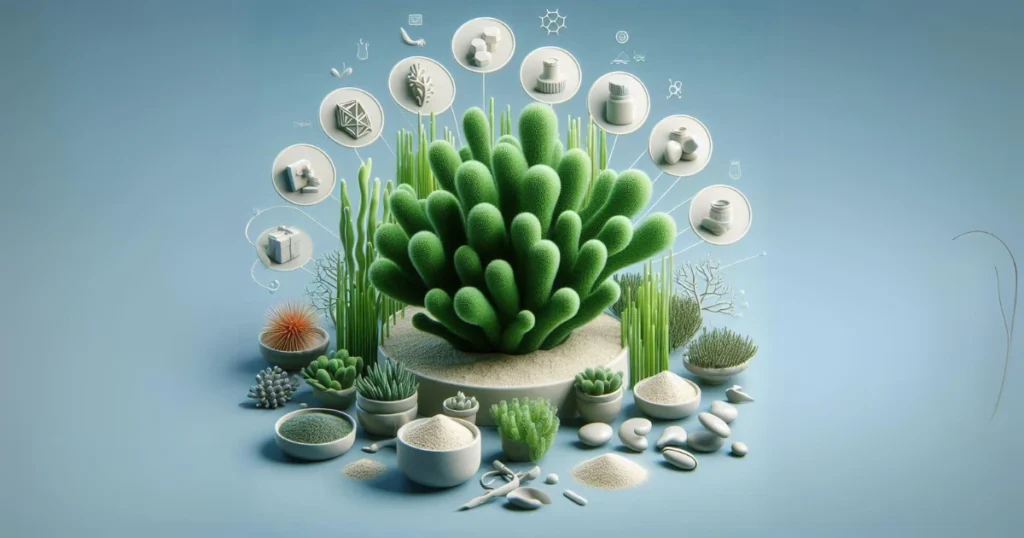
People predominantly collect sea moss, commonly referred to as Irish sea moss or red seaweed, for its use in health supplements and as a thickening agent in various commercial food products.
If you are familiar with sea moss supplements, you might be curious about the various methods of consumption and whether there are alternative ways to incorporate sea moss into your diet.
This article explores the potential advantages and disadvantages of sea moss, including its nutritional profile and preparation methods.
What is sea moss?
Sea moss, or Chondrus crispus in scientific terms, is a form of algae or seaweed. It thrives in the rocky waters of the Atlantic, predominantly found between North America and Europe.
This edible marine plant shares similarities with other seaweeds and leafy sea vegetables, including kelp and dulse.
Sea moss is available in various colors, including green, yellow, purple, red, brown, and black.
People typically find the most prevalent varieties in warmer waters, and they commonly refer to them as Irish moss.
Sea moss nutrients
Red seaweeds, such as sea moss, are rich in a variety of vitamins and minerals. They are inherently low in calories, fat, and sugar, while also offering a modest amount of plant-based protein.
A serving of raw Irish sea moss, consisting of 4 tablespoons (20 grams), delivers the following nutrients:
- Calories: 10
- Protein: 0.5 grams
- Total fat: 0 grams
- Total carbs: 3 grams
- Fiber: 0.5 grams
- Total sugar: 0 grams
- Calcium: 1% of the Daily Value (DV)
- Iron: 10% of the DV
- Magnesium: 7% of the DV
- Phosphorus: 2% of the DV
- Zinc: 4% of the DV
- Copper: 3% of the DV
Sea moss, like other types of sea vegetables, is a naturally rich source of iodine, an important micronutrient that supports thyroid health.
In addition, red seaweeds such as sea moss are abundant in antioxidants, which are compounds that play a crucial role in protecting cells from oxidative damage associated with disease.
Potential benefits
Many individuals incorporate seamoss into their wellness routines due to its supposed health benefits. It is important to highlight that a considerable portion of these benefits is anecdotal and does not possess strong scientific evidence. While there is a more comprehensive array of studies focused on the health benefits of seaweed and algae, some of these findings may also be applicable to sea moss, as they thrive in comparable environments.
Researchers need to conduct further scientific inquiry to assess the specific impacts of sea moss. The primary potential benefits of using sea moss may include:
- Potential support for thyroid health: Seaweeds are abundant in iodine, an essential micronutrient vital for optimal thyroid function.
- Potential enhancement of immunity: Research involving salmon has indicated that seaweed supplementation may enhance immune modulation and response. Further studies are required to determine its effects on human immunity.
- Potential improvement of gut health: Seaweeds provide a rich source of live probiotic bacteria and fiber, both of which contribute to a healthy gut microbiome.
- Potential assistance in weight loss: Seaweeds and microalgae are rich in dietary fiber, which can promote a sense of fullness and help prevent overeating. Certain studies propose that fucoxanthin, a compound present in seaweed, could exhibit properties that combat obesity.
- Potential promotion of heart health: Certain studies have indicated that components within seaweed may aid in lowering cholesterol and blood pressure, potentially reducing the risk of heart disease.
- Anecdotal claims regarding fertility: While there is no scientific evidence supporting the notion that sea moss enhances fertility, some individuals utilize it as a traditional remedy for fertility issues. Scientists should further investigate this area.
- Improve blood sugar management: Research on mice shows that fucoxanthin in seaweed may lower elevated blood sugar levels, potentially enhancing blood sugar management.
Although the prospective health advantages of sea moss appear encouraging, it is crucial to recognize that the majority of existing research pertains to seaweed or elements derived from marine flora rather than sea moss itself. Researchers have primarily conducted these studies in vitro or on animal subjects rather than on human populations.
Consequently, there is a significant need for further research involving human subjects to thoroughly investigate the health implications of sea moss.
Downsides
The lack of research on the health benefits and nutritional makeup of sea moss is one of the main issues.
Similar to other seaweeds, the nutritional profile of sea moss can vary significantly, complicating the understanding of its specific contents and their respective quantities.
The cultivation environment of sea vegetables significantly affects the concentrations of micronutrients and fatty acids present in them.
This variability may expose consumers to the risk of excessive iodine intake, which can lead to health complications.
Excessive iodine consumption can result in hypothyroidism, a condition characterized by an underactive thyroid gland, which is crucial for regulating growth and metabolism.
Additionally, there is a potential risk of heavy metal accumulation, as seaweed has the capacity to absorb and retain heavy metals in significant quantities.
Nevertheless, the likelihood of toxicity appears to be minimal. A study investigated the presence of 20 heavy metals in eight varieties of seaweed sourced from European and Asian waters, concluding that heavy metal levels did not present serious health threats.
Given these uncertainties, it is advisable to consume seaweed in moderation.
How to prepare sea moss
You can prepare sea moss in various ways. It is available in raw, dried form at many health food stores and online retailers.
One of the most common methods of consumption is to create gel from the raw sea moss at home.
To make sea moss gel, soak the raw sea moss in water overnight, then rinse and blend it with fresh water until you achieve a smooth consistency.
After blending, transfer the mixture to an airtight container and refrigerate it overnight to allow it to set into a gel.
Some supplement companies prepare sea moss as gel. Manufacturers recommend consuming this gel directly or incorporating it into various foods and beverages.
Additional methods of consuming sea moss include mixing it into drinks, sprinkling it on yogurt or oatmeal, and adding it to a variety of dishes.
The form in which you purchase sea moss determines its shelf life.
Numerous advocates of sea moss assert that when stored in the refrigerator, prepared sea moss gel can remain usable for several weeks, despite the limited scientific research on the subject.
You can also freeze it.Nonetheless, similar to most prepared foods and leftovers stored in cold conditions, it is advisable to exercise caution and limit storage to 3 to 5 days to reduce the risk of foodborne illnesses.
Who should not take sea moss?
Sea moss, particularly when consumed in significant amounts, has the potential to lead to adverse effects and may pose safety concerns for certain individuals, including those with hypothyroidism.
Although allergies to seaweed and sea moss are rare, it remains possible to develop an allergy to sea moss. Should you experience any allergic reactions, such as itching or hives, it is advisable to seek medical assistance. Severe allergic reactions, characterized by symptoms like throat swelling or breathing difficulties, necessitate immediate emergency care.
The bottom line
Sea moss, scientifically known as Chondrus crispus, is a spiny marine plant that resembles seaweeds and algae.
Companies primarily harvest it for its carrageenan, using it as a natural thickening agent in various food products and dietary supplements. Additionally, individuals can prepare it as a gel at home or incorporate it into different foods and beverages with ease.
This sea vegetable is rich in a variety of vitamins, minerals, and antioxidants that may contribute positively to overall health. However, its nutritional profile can differ, and excessive consumption may lead to elevated levels of iodine or heavy metals.
In conclusion, further scientific investigation is necessary to fully understand the health implications of sea moss for humans and its effectiveness in health-related products. Nevertheless, preliminary studies on seaweeds and algae suggest that some potential benefits may exist.


